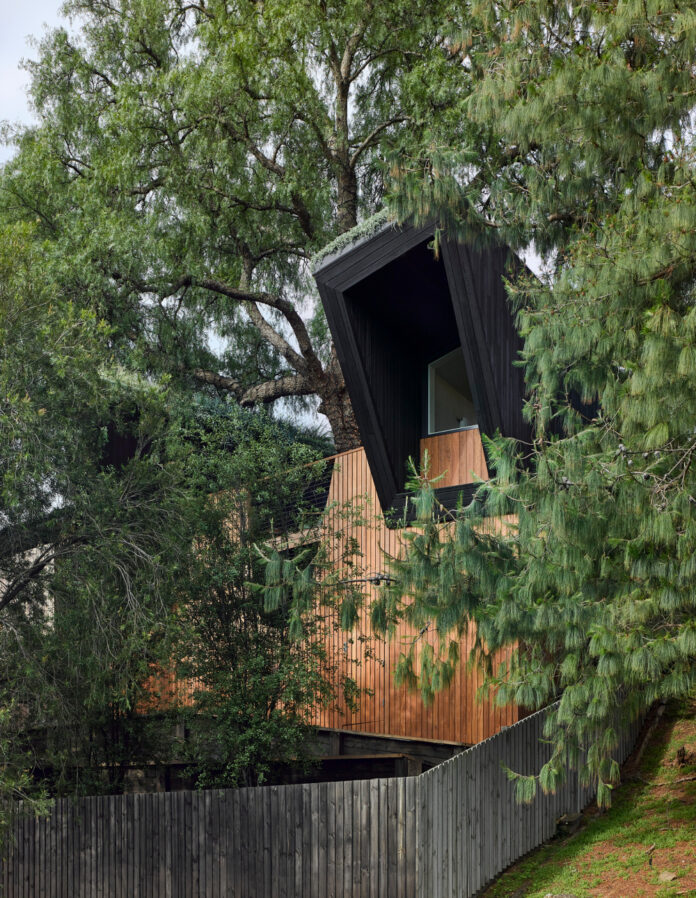[ad_1]
A Compact Passive House Built Around A Pepper Tree
Sustainable Homes

Pepper Tree Passive House by Alexander Symes Architect is a secondary dwelling accompanying an existing family home in Wollongong. Photo – Barton Taylor

A new wraparound deck on the existing home creates spaces for entertaining that provide both a noise and visual buffer to the street, and direct views over the street tree canopies towards Mount Kembla. Photo – Barton Taylor

The external staircase was built using materials of a roof structure form a demolished Bondi home. Photo – Barton Taylor

The entrance to the building, which functions as an office and can alternatively be rented as short stay accommodation. Photo – Barton Taylor

The deck between the two wings of the new structure, accomodating the existing pepper tree. Photo – Barton Taylor

The two cantilevered wings each host a green roof, filled with native Australian plants, blending the building into the landscape. Photo – Barton Taylor

The living area. Interior design by Paiano Design. Artwork by Tanya Stubbles. Photo – Barton Taylor

A breakfast nook offers the best views in the house. Interior design by Paiano Design. Photo – Barton Taylor

The U-shaped floorplan spans 60 square metres internally. Interior design by Paiano Design. Photo – Barton Taylor

In designing a secondary structure, Alexander Symes Architect have added much needed usable floor space to a suburban site without overdeveloping or sacrificing its biophilic connection. Interior design by Paiano Design. Photos – Barton Taylor

The bedroom. Interior design by Paiano Design. Photo – Barton Taylor
The creation of Pepper Tree Passive House by Alexander Symes Architect began several years ago in collaboration with builder and client Adam Souter of Souter Built, who lives on the property with partner Ame Rooke-Jones, and their three young children.
The family’s Wollongong home was tired and thermally inefficient, but functionally adequate. Instead of spending their budget on significant upgrades to the existing house, they decided to build a new, separate structure on the rear of the site to a Passive House standard.
‘This meant they would get the best amenity value for their budget with minor performance based upgrades to the existing home including new insulation, cladding, repainting the concrete tiles a lighter colour to reduce heat gain, and a 12kW solar panel awning that provides shade to the outdoor spaces in summer,’ says Alexander Symes, director of Alexander Symes Architect.
After the initial concept was developed, Adam began salvaging and storing landfill-bound materials from his other construction projects to eventually use in his home.
The resulting secondary dwelling takes the form of an elevated U-shaped building wrapping around an existing 60-year-old tree.
‘We decided at our initial meeting that the pepper tree was part of the core identity of the site and keeping it would be a great benefit to the final outcome, rather than just another box-shaped granny flat,’ says Alexander.
Two cantilevered wings are clad with recycled shou sugi ban cladding, and each host a green roof blending the building into the landscape.
Adam’s salvaged construction materials were used throughout the project, including on the external staircase built using the roof structure of a demolished Bondi home, contributing to its sustainable Passive House standard.
The completed self-contained home includes one bedroom, a kitchen, living area, bathroom, and a laundry across 60 square metres internally. The building functions as an office for Adam’s growing company, which can alternatively be rented as short stay accommodation.
In designing a secondary structure, Alexander Symes Architect have added much needed usable floor space to a suburban site without overdeveloping or sacrificing its biophilic connection. This approach provides a precedent for creating small, future proofed additions without the massive cost of upgrading all existing dwellings.
[ad_2]
thedesignfiles.net










